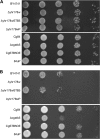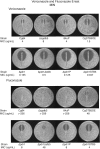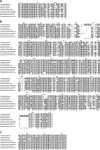STB5 is a negative regulator of azole resistance in Candida glabrata
- PMID: 23229483
- PMCID: PMC3553707
- DOI: 10.1128/AAC.01278-12
STB5 is a negative regulator of azole resistance in Candida glabrata
Abstract
The opportunistic yeast pathogen Candida glabrata is recognized for its ability to acquire resistance during prolonged treatment with azole antifungals (J. E. Bennett, K. Izumikawa, and K. A. Marr. Antimicrob. Agents Chemother. 48:1773-1777, 2004). Resistance to azoles is largely mediated by the transcription factor PDR1, resulting in the upregulation of ATP-binding cassette (ABC) transporter proteins and drug efflux. Studies in the related yeast Saccharomyces cerevisiae have shown that Pdr1p forms a heterodimer with another transcription factor, Stb5p. In C. glabrata, the open reading frame (ORF) designated CAGL0I02552g has 38.8% amino acid identity with STB5 (YHR178w) and shares an N-terminal Zn(2)Cys(6) binuclear cluster domain and a fungus-specific transcriptional factor domain, prompting us to test for homologous function and a possible role in azole resistance. Complementation of a Δyhr178w (Δstb5) mutant with CAGL0I02552g resolved the increased sensitivity to cold, hydrogen peroxide, and caffeine of the mutant, for which reason we designated CAGl0I02552g CgSTB5. Overexpression of CgSTB5 in C. glabrata repressed azole resistance, whereas deletion of CgSTB5 caused a modest increase in resistance. Expression analysis found that CgSTB5 shares many transcriptional targets with CgPDR1 but, unlike the latter, is a negative regulator of pleiotropic drug resistance, including the ABC transporter genes CDR1, PDH1, and YOR1.
Figures






Similar articles
-
Pdr1 regulates multidrug resistance in Candida glabrata: gene disruption and genome-wide expression studies.Mol Microbiol. 2006 Aug;61(3):704-22. doi: 10.1111/j.1365-2958.2006.05235.x. Epub 2006 Jun 27. Mol Microbiol. 2006. PMID: 16803598
-
Activity of Isavuconazole and Other Azoles against Candida Clinical Isolates and Yeast Model Systems with Known Azole Resistance Mechanisms.Antimicrob Agents Chemother. 2015 Oct 19;60(1):229-38. doi: 10.1128/AAC.02157-15. Print 2016 Jan. Antimicrob Agents Chemother. 2015. PMID: 26482310 Free PMC article.
-
Similarities and distinctions in the activation of the Candida glabrata Pdr1 regulatory pathway by azole and non-azole drugs.mSphere. 2024 Dec 19;9(12):e0079224. doi: 10.1128/msphere.00792-24. Epub 2024 Nov 18. mSphere. 2024. PMID: 39555934 Free PMC article.
-
Multiple interfaces control activity of the Candida glabrata Pdr1 transcription factor mediating azole drug resistance.Curr Genet. 2019 Feb;65(1):103-108. doi: 10.1007/s00294-018-0870-4. Epub 2018 Jul 28. Curr Genet. 2019. PMID: 30056490 Free PMC article. Review.
-
Characterization of the multi-drug efflux systems of pathogenic fungi using functional hyperexpression in Saccharomyces cerevisiae.Nihon Ishinkin Gakkai Zasshi. 2010;51(2):79-86. doi: 10.3314/jjmm.51.79. Nihon Ishinkin Gakkai Zasshi. 2010. PMID: 20467195 Review.
Cited by
-
Loss-of-Function ROX1 Mutations Suppress the Fluconazole Susceptibility of upc2AΔ Mutation in Candida glabrata, Implicating Additional Positive Regulators of Ergosterol Biosynthesis.mSphere. 2021 Dec 22;6(6):e0083021. doi: 10.1128/msphere.00830-21. Epub 2021 Dec 22. mSphere. 2021. PMID: 34935446 Free PMC article.
-
An Overview on Conventional and Non-Conventional Therapeutic Approaches for the Treatment of Candidiasis and Underlying Resistance Mechanisms in Clinical Strains.J Fungi (Basel). 2020 Feb 10;6(1):23. doi: 10.3390/jof6010023. J Fungi (Basel). 2020. PMID: 32050673 Free PMC article. Review.
-
A TRP1-marker-based system for gene complementation, overexpression, reporter gene expression and gene modification in Candida glabrata.FEMS Yeast Res. 2021 Jan 6;20(8):foaa066. doi: 10.1093/femsyr/foaa066. FEMS Yeast Res. 2021. PMID: 33289831 Free PMC article.
-
Membrane Proteomics Analysis of the Candida glabrata Response to 5-Flucytosine: Unveiling the Role and Regulation of the Drug Efflux Transporters CgFlr1 and CgFlr2.Front Microbiol. 2016 Dec 21;7:2045. doi: 10.3389/fmicb.2016.02045. eCollection 2016. Front Microbiol. 2016. PMID: 28066366 Free PMC article.
-
A Network of Paralogous Stress Response Transcription Factors in the Human Pathogen Candida glabrata.Front Microbiol. 2016 May 9;7:645. doi: 10.3389/fmicb.2016.00645. eCollection 2016. Front Microbiol. 2016. PMID: 27242683 Free PMC article.
References
-
- Vermitsky JP, Earhart KD, Smith WL, Homayouni R, Edlind TD, Rogers PD. 2006. Pdr1 regulates multidrug resistance in Candida glabrata: gene disruption and genome-wide expression studies. Mol. Microbiol. 61:704–722 - PubMed
Publication types
MeSH terms
Substances
Grants and funding
LinkOut - more resources
Full Text Sources
Molecular Biology Databases

